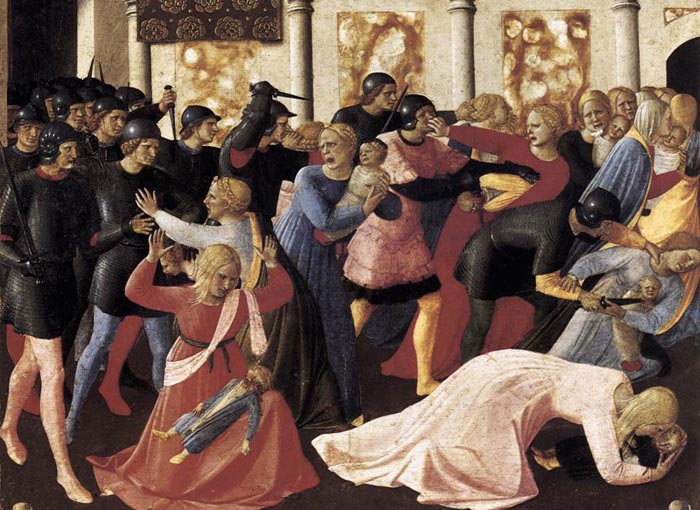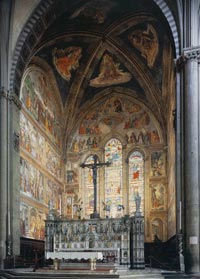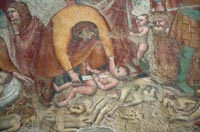| The Massacre of the Innocents |
| The Golden Legend or Legenda aurea or Legenda sanctorum, is a collection of hagiographies by Jacobus de Voragine that became a late medieval bestseller. The Legenda aurea was the most popular and most widespread religious folk book of the middle ages. In its time it was read more often than the Bible and it was Jacobus Voragine's main work. Art in Tuscany | The Golden Legend (Legenda aurea or Legenda sanctorum) |
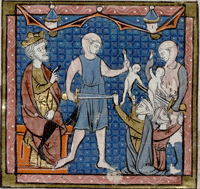 Jacobus de Voragine, Legenda aurea, Massacre of the Innocents, Henry E. Huntington Library and Art Gallery, San Marino, California Jacobus de Voragine, Legenda aurea, Massacre of the Innocents, Henry E. Huntington Library and Art Gallery, San Marino, California |
|
| Giotto Di Bondone | The Massacre of the Innocents | 1310s |
||
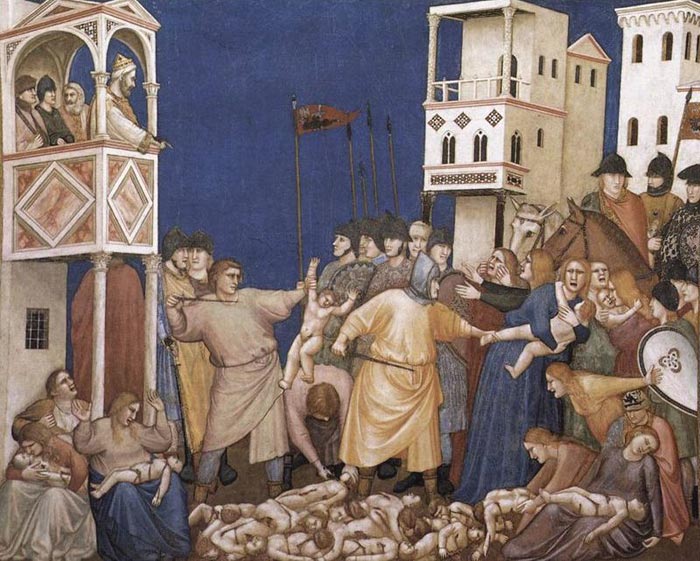 |
||
Giotto Di Bondone | The Massacre of the Innocents, orth transept, Lower Church, San Francesco, Assisi
|
||
Frescoes on the ceiling of the north transept of the Lower Church in Assisi. |
||
Fra Angelico, Armadio degli Argenti, Massacre of the Innocents, 1451-52
|
||
 |
||
Fra Angelico, Massacre of the Innocents, 1451-52, tempera on wood, 38,5 x 37 cm, Museo di San Marco, Florence |
||
The Basilica della Santissima Annunziata (Basilica of the Most Holy Annunciation) is a Roman Catholic minor basilica in Florence and the mother church of the Servite order. It is located at the northeastern side of the Piazza Santissima Annunziata.
|
||
Sano di Pietro, The Massacre of the Innocents, 1470
|
||
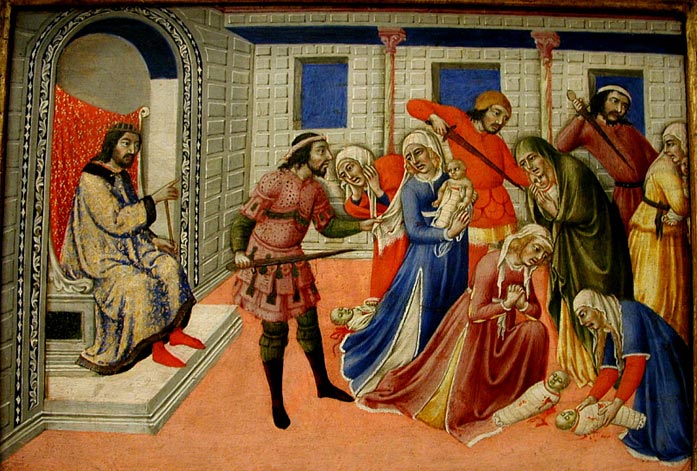 |
||
Sano di Pietro, The Massacre of the Innocents, 1470, Metropolitan Museum of Art, New York |
||
| The panels The Massacre of the Innocents, The Adoration of the Magi, and two others probably formed the predella of an altarpiece, probably that of the "Purification of the Virgin" formerly in the cathedral of Massa Marittima. The pictures, from about 1470, are typical of Sano's popular, conservative approach to painting, appreciated by the Franciscan order. |
||
|
||
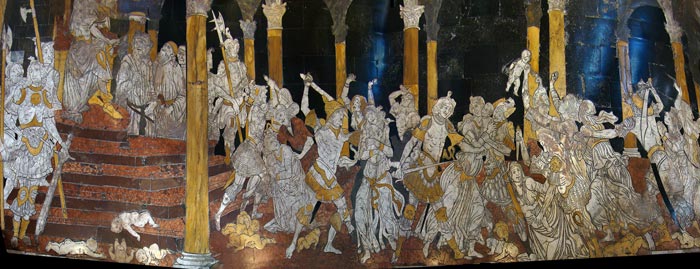 |
||
Matteo di Giovanni, Floor mosaic Strage degli Innocenti (Slaughter of the Innocents) by Matteo di Giovanni in the Cathedral of Siena (detail)
|
||
The inlaid marble mosaic floor is one of the most ornate of its kind in Italy, covering the whole floor of the cathedral.The inlaid marble mosaic floor is one of the most ornate of its kind in Italy, covering the whole floor of the cathedral. This undertaking went on from the fourteenth to the sixteenth centuries, and about forty artists made their contribution. The floor consists of 56 panels in different sizes. Most have a rectangular shape, but the later ones in the transept are hexagons or rhombuses. They represent the sibyls, scenes from the Old Testament, allegories and virtues. Most are still in their original state. The earliest scenes were made by a graffito technique: drilling tiny holes and scratching lines in the marble and filling these with bitumen or mineral pitch. In a later stage black, white, green, red and blue marble intarsia were used. This technique of marble inlay also evolved during the years, finally resulting in a vigorous contrast of light and dark, giving it an almost modern, impressionistic composition. |
||
|
||
 |
||
Matteo di Giovanni, Massacre of the Innocents, Massacre of the Innocents, 1482, Ospedale Santa Maria della Scala, Siena
|
||
The Chapel of our Lady also holds one of the four versions of the Massacre of the Innocents, which Matteo di Giovanni, an artist born in Sansepolcro, and one of the leading figures of fifteenth-century Sienese art, painted in the course of a decade. The canvas on deposit at Santa Maria della Scala, is the work made by the artist in 1482 for the church of Sant'Agostino in Siena. |
||
Matteo di Giovanni, Massacre of the Innocents, 1488, Galleria Nazionale di Capodimonte, Naples |
||
|
||
Domenico Ghirlandaio | The Adoration of the Magi, Slaughter of the Innocents
|
||
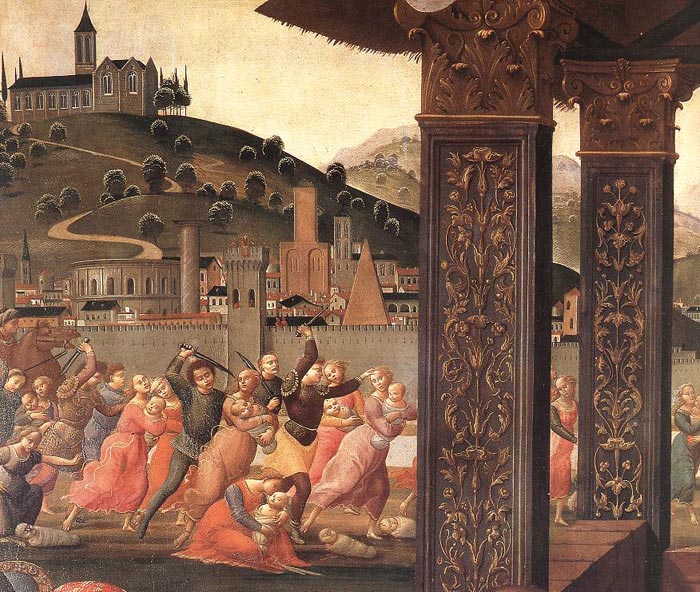 |
||
Domenico Ghirlandaio, Adoration of the Magi (detail, Slaughter of the Innocents), 1488, Spedale degli Innocenti, Firenze |
||
| In temperament and approach, however, Ghirlandaio differed from both of his putative painting teachers. "Pronto, presto, e facile," as Vasari described him, Ghirlandaio simplified their painstakingly realistic styles into one more suitable for fresco. The artist was, in fact, primarily active in that medium, creating extensive fresco cycles in Rome (Sistine Chapel, 1481-1482) and elsewhere. His most notable Florentine cycles are in the Sassetti chapel in Santa Trinità (1483-1485) and in the choir, patronized by the Tornabuoni family, in Santa Maria Novella (1486-1490). To complete such vast undertakings Ghirlandaio employed a highly organized workshop, which included not only his brothers Davide and Benedetto but also his brother-in-law Sebastiano Mainardi, and even the young Michelangelo. On 28 October 1485, the Francesco di Giovanni Tesori, the prior of an orphanage ordered a panel painting of the Adoration of the Magi from Ghirlandaio. The picture was intended for the main altar of the Spedale degli Innocenti, a foundling hospital. In the harrowing scene of the Slaughter of the Innocents in the background, Berenson recognized the hand of Bartolomeo di Giovanni, the author of the stories from the predella, whom he poetically called "Domenico's friend". The town beyond this, in which we can see monuments such as the Colosseum, Trajan's Column, the Torre delle Milizie, and a pyramid, is meant to be reminiscent of Rome. |
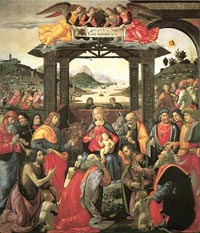 |
|
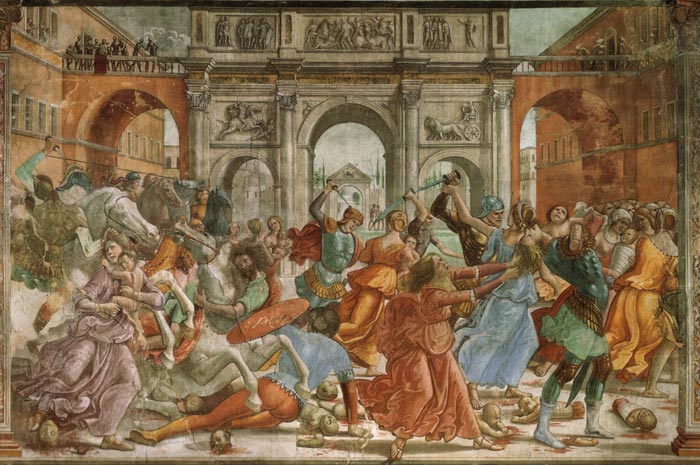 |
||
Domenico Ghirlandaio,detail, Slaughter of the Innocents), fresco in the Cappella Tornabuoni, Santa Maria Novella, Firenze
|
||
The Tornabuoni Chapel, or Cappella Tornabuoni, is the main chapel in the church of Santa Maria Novella in Florence. It is famous for the extensive and well-preserved fresco cycle on its walls, one of the most complete in the city, which was created by Domenico Ghirlandaio and his workshop between 1485 and 1490.
|
||
|
||
| The Basilica Church of Santa Maria dei Servi is a 13th century church, built on the site of the former San Clement church and annexed to a new convent. The church is notable for its a fine Romanesque bell tower and famous fresco inside. The church stands on the southern end of Piazza Alessandro Manzoni, south-east of the Siena Cathedral and Piazza del Campo. The simple west facade of the church, with a single portal and a rose window, remains unfinished. The Romanesque campanile (13th century) has four orders of windows, increasing in number as they go up in order to enhance the effect of perspective. It was thoroughly restored in the 20th century. Inside is a central nave flanked by two aisles and a number of notable artworks. On the right is the Madonna del Bordone (the Virgin and Child with two Angels) by Coppo di Marcovaldo (1261). In the second chapel in the south transept is the famous Slaughter of the Innocents fresco by Pietro Lorenzetti (c. 1330). The altarpiece is Lippo Memmi's Madonna del Pópolo (c. 1317). Also notable are a Crucifix of the 14th century and a holy water stoup of the 13th century.
|
||
|
||
[1] The Church Latin writer and archbishop Jacobus de Voragine, also known as Jacobus a Voragine or "Varagine", was born in Voragine, today's Varazze near Genoa, Italy, in 1230. In 1244 he entered the Dominican order and at the age of 22 became a professor. Jacobus de Voragine was an extraordinary and brilliant speaker, he taught at various schools of the order and worked as an itinerant preacher. From 1267 to 1278 and again from 1281 to 1286 he was a provincial of Lombardy and mediated in the conflict between the Guelfs and the Ghibellines on behalf of Pope Honorius IV. Two years later he he was elected archbishop of Genoa and took up office in 1292. On July 14, 1292 he was buried under the main altar of the Dominican church in Genoa. "Legenda aurea", the "Golden Legend" is the most popular and most widespread religious folk book of the middle ages. In its time it was read more often than the Bible and it was Jacobus Voragine's main work. The history of the medieval illuminated book in western Europe began with the introduction of the Christian faith into those regions which had been dominated during the 5th and 6th cen- turies, the aptly named Dark Ages, by the migrating Germanic peoples. Christianity is a book-based religion, its central pivot the Four Gospels chronicling the life, death and resurrection of the Son of God. Access to a copy of this text was a fundamental requirement for every priest, both as a foundation for his teaching and as a central necessity in the performance of the liturgy. Such a book would naturally be the first to inspire decoration within and without, to provide a visual focus for the devotions of the newly faithful, most of whom would for a long time have remained illit- erate and mindful of their pagan roots. Copies of the gospels were thus for several centuries the target of the finest endeavours of illuminators. Janet Backhouse, The Illuminated Page: Ten Centuries of Manuscript Painting in the British Library, British Library, London, 1997 | www.questia.com [1] Giotto di Bondone (c. 1267–January 8, 1337), better known simply as Giotto, was an Italian painter and architect from Florence. He is generally considered the first in a line of great artists who contributed to the Italian Renaissance. Giotto's contemporary Giovanni Villani wrote that Giotto was "the most sovereign master of painting in his time, who drew all his figures and their postures according to nature. And he was given a salary by the commune [of Florence] in virtue of his talent and excellence." The later 16th century biographer Giorgio Vasari says of him "...He made a decisive break with the ...Byzantine style, and brought to life the great art of painting as we know it today, introducing the technique of drawing accurately from life, which had been neglected for more than two hundred years." Giotto's masterwork is the decoration of the Scrovegni Chapel in Padua, commonly called the Arena Chapel, completed around 1305. This fresco cycle depicts the life of the Virgin and the life of Christ. It is regarded as one of the supreme masterpieces of the Early Renaissance. That Giotto painted the Arena Chapel and that he was chosen by the commune of Florence in 1334 to design the new campanile (bell tower) of the Florence Cathedral are among the few certainties of his biography. Almost every other aspect of it is subject to controversy: his birthdate, his birthplace, his appearance, his apprenticeship, the order in which he created his works, whether or not he painted the famous frescoes at Assisi, and where he was eventually buried after his death. [2] MATTEO DI GIOVANNI: an account of a painted massacre, 23rd June - 08th October 2006
|
||
| This page incorporates material from the Wikipedia article Massacre of the Innocents, published under the GNU Free Documentation License. | ||

